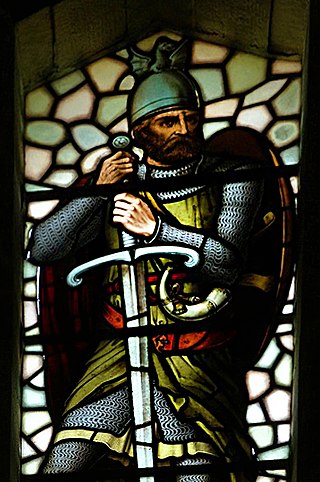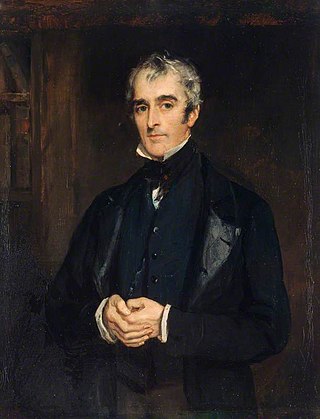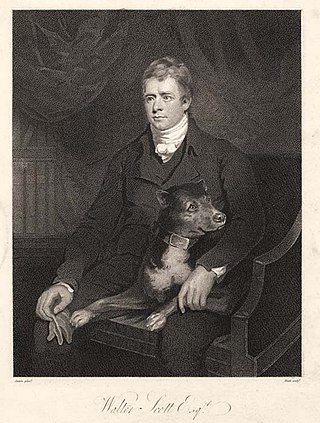
Sir Walter Scott, 1st Baronet, was a Scottish historian, novelist, poet, and playwright. Many of his works remain classics of European and Scottish literature, notably the novels Ivanhoe (1819), Rob Roy (1817), Waverley (1814), Old Mortality (1816), The Heart of Mid-Lothian (1818), and The Bride of Lammermoor (1819), along with the narrative poems Marmion (1808) and The Lady of the Lake (1810). He had a major impact on European and American literature.

Sir William Wallace was a Scottish knight who became one of the main leaders during the First War of Scottish Independence.

John Gibson Lockhart was a Scottish writer and editor. He is best known as the author of the seminal, and much-admired, seven-volume biography of his father-in-law Sir Walter Scott: Memoirs of the Life of Sir Walter Scott, Bart. He produced four novels in the early 1820s including Adam Blair and Reginald Dalton.

James Robert Hope-Scott was a British barrister and Tractarian.

William Cosmo Gordon Lang, 1st Baron Lang of Lambeth, was a Scottish Anglican prelate who served as Archbishop of York (1908–1928) and Archbishop of Canterbury (1928–1942). His elevation to Archbishop of York, within 18 years of his ordination, was the most rapid in modern Church of England history. As Archbishop of Canterbury during the abdication crisis of 1936, he took a strong moral stance, his comments in a subsequent broadcast being widely condemned as uncharitable towards the departed king.

John Graham, 7th of Claverhouse, 1st Viscount Dundee was a Scottish soldier and nobleman, a Tory and an Episcopalian. He was responsible for policing southwest Scotland during and after the religious unrest and rebellion of the late 17th century, and went on to lead the Jacobite rising of 1689.
A royal peculiar is a Church of England parish or church exempt from the jurisdiction of the diocese and the province in which it lies, and subject to the direct jurisdiction of the monarch or, in Cornwall, of the Duke of Cornwall.

Jonathan Oldbuck is the leading character in Sir Walter Scott's 1816 novel The Antiquary. In accordance with Scottish custom he is often addressed by the name of his house, Monkbarns. He is devoted to the study and collection of old coins, books and archaeological relics, and has a marked tendency to misogyny due to disappointment in an early love affair. His characteristics have been traced back to several men known to Scott, and to the author himself, an enthusiastic antiquary. Many critics have considered him one of Scott's finest creations.

Adventure fiction is a type of fiction that usually presents danger, or gives the reader a sense of excitement. Some adventure fiction also satisfies the literary definition of romance fiction.
Tillietudlem is a fictional castle in Walter Scott's 1816 novel Old Mortality, and a modern settlement in South Lanarkshire, Scotland.

Minstrelsy of the Scottish Border is an anthology of Border ballads, together with some from north-east Scotland and a few modern literary ballads, edited by Walter Scott. It was first published by Archibald Constable in Edinburgh in 1802, but was expanded in several later editions, reaching its final state in 1830, two years before Scott's death. It includes many of the most famous Scottish ballads, such as Sir Patrick Spens, The Young Tamlane, The Twa Corbies, The Douglas Tragedy, Clerk Saunders, Kempion, The Wife of Usher's Well, The Cruel Sister, The Dæmon Lover, and Thomas the Rhymer. Scott enlisted the help of several collaborators, notably John Leyden, and found his ballads both by field research of his own and by consulting the manuscript collections of others. Controversially, in the editing of his texts he preferred literary quality over scholarly rigour, but Minstrelsy of the Scottish Border nevertheless attracted high praise from the first. It was influential both in Britain and on the Continent, and helped to decide the course of Scott's later career as a poet and novelist. In recent years it has been called "the most exciting collection of ballads ever to appear."

Slave Ship is a 1937 American historical adventure film directed by Tay Garnett and starring Warner Baxter, Wallace Beery and Elizabeth Allan. The supporting cast features Mickey Rooney, George Sanders, Jane Darwell, and Joseph Schildkraut. It is one of very few films out of the forty-eight that Beery made during the sound era for which he did not receive top billing.

William, Earl of Glenallan, otherwise Lord Glenallan, is a character in Sir Walter Scott's 1816 novel The Antiquary, a Scottish aristocrat whose life has been ruined by the suicide of his wife and the belief that he has unwittingly committed incest. His story forms the melodramatic Gothic strand in an otherwise largely realistic comic novel.

Romanticism in Scotland was an artistic, literary and intellectual movement that developed between the late eighteenth and the early nineteenth centuries. It was part of the wider European Romantic movement, which was partly a reaction against the Age of Enlightenment, emphasising individual, national and emotional responses, moving beyond Renaissance and Classicist models, particularly into nostalgia for the Middle Ages. The concept of a separate national Scottish Romanticism was first articulated by the critics Ian Duncan and Murray Pittock in the Scottish Romanticism in World Literatures Conference held at UC Berkeley in 2006 and in the latter's Scottish and Irish Romanticism (2008), which argued for a national Romanticism based on the concepts of a distinct national public sphere and differentiated inflection of literary genres; the use of Scots language; the creation of a heroic national history through an Ossianic or Scottian 'taxonomy of glory' and the performance of a distinct national self in diaspora.

The novel in Scotland includes all long prose fiction published in Scotland and by Scottish authors since the development of the literary format in the eighteenth century. The novel was soon a major element of Scottish literary and critical life. Tobias Smollett's picaresque novels, such as The Adventures of Roderick Random and The Adventures of Peregrine Pickle mean that he is often seen as Scotland's first novelist. Other Scots who contributed to the development of the novel in the eighteenth century include Henry Mackenzie and John Moore.

Scottish literature in the nineteenth century includes all written and published works in Scotland or by Scottish writers in the period. It includes literature written in English, Scottish Gaelic and Scots in forms including poetry, novels, drama and the short story.
Events from the year 1807 in Scotland.

Letters on Demonology and Witchcraft Addressed to J. G. Lockhart, Esq. (1830) was a study of witchcraft and the supernatural by Sir Walter Scott. A lifelong student of folklore, Scott was able to draw on a wide-ranging collection of primary and secondary sources. His book found many readers throughout the 19th century, and exercised a significant influence in promoting the Victorian vogue for Gothic and ghostly fiction. Though on first publication it met with mixed reviews, it is now recognised as a pioneering work of scientific anthropology, treating of its subject in an acute and analytical way which prefigures later scholarship on the subject, as well as presenting a highly readable collection of supernatural anecdotes.
Illustrations of Northern Antiquities (1814), or to give its full title Illustrations of Northern Antiquities, from the Earlier Teutonic and Scandinavian Romances; Being an Abstract of the Book of Heroes, and Nibelungen Lay; with Translations of Metrical Tales, from the Old German, Danish, Swedish, and Icelandic Languages; with Notes and Dissertations, was a pioneering work of comparative literature which provided translations and abstracts of various works written in medieval Germany and Scandinavia. Its three authors were Henry Weber, who précised the Nibelungenlied and Heldenbuch; Robert Jamieson, who translated Danish and other ballads, stressing their close connection with Scottish ballads; and Walter Scott, who provided an abstract of Eyrbyggja saga. It significantly extended British readers' access to early Germanic literature.
Walter Scott's "Memoirs", first published as "Memoir of the Early Life of Sir Walter Scott, Written by Himself" and also known as the Ashestiel fragment, is a short autobiographical work describing the author's ancestry, parentage, and life up to the age of 22. It is the most important source of information we have on Scott's early life. It was mainly written between 1808 and 1811, then revised and completed in 1826, and first published posthumously in 1837 as Chapter 1 of J. G. Lockhart's multi-volume Memoirs of the Life of Sir Walter Scott, Bart. It was re-edited in 1981 by David Hewitt.














